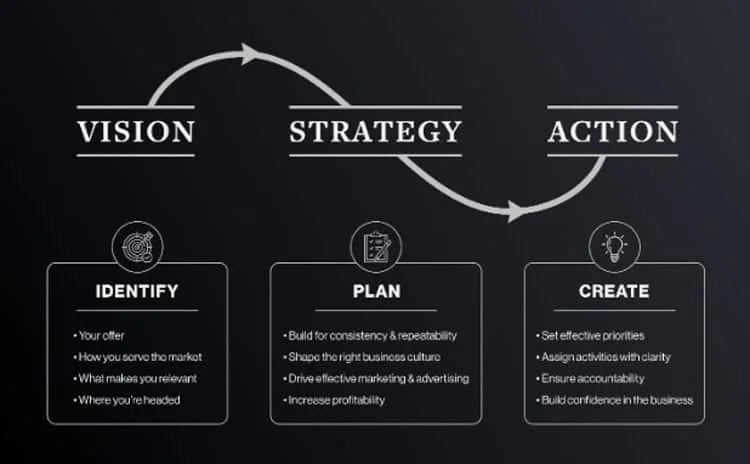Navigating Organizational Friction: How the VSA Framework Helps Companies Transition Without Breaking
By Mark Chiaravalloti
Most companies don’t collapse from a single catastrophic mistake. They decline slowly, as unseen friction builds up. Market relevance slips, processes stagnate, leaders miss the signals, until it’s too late to correct course. By the time traditional “change management” is called in, you’re already on defense, patching leaks instead of steering the ship.
This friction is everywhere: a product line that hasn’t been updated in years, a sales process that lags digital competitors, and leadership teams misaligned on priorities. At first, the signs are subtle. Left unaddressed, friction becomes a drag that slows momentum, frustrates teams, and erodes market position.
After more than 25 years leading transformations across industries from advising Fortune 100 giants like Amazon and Microsoft to steering companies through M&A deals valued at more than $3.4 billion, I’ve learned one thing: friction isn’t just inevitable, it’s predictable. And if you can see it coming, you can lead through it.
Research shows that nearly 70% of business transformations fail; not because leaders lacked effort or vision, but because they reacted too late. By the time they addressed the friction, it had already become systemic.
That’s where the VSA Framework comes in.
VSA: A Leadership Discipline for the Transition Era
VSA: Vision, Strategy, Action, is the framework I’ve used for decades to help businesses navigate their most critical transitions.
· Vision clarifies where the business is headed. Not just a mission statement on a wall, but an evolving understanding of the company’s identity and relevance in the market.
· Strategy builds the path to get there, ensuring methods, products, and teams are aligned for what’s next.
· Action turns plans into execution, with accountability and measurable results.
It’s deceptively simple, but that simplicity is what makes it work across sectors. I’ve applied it to private equity-backed turnarounds, global consumer brands, and emerging tech companies alike.
Consider one client: a company whose top-selling product was nearing obsolescence. Instead of waiting for sales to tailspin, we used VSA to roadmap the next generation. Redefining their Vision (the role they would play in a shifting market), building the Strategy (defining technologies and channels that matter most), and driving disciplined Action (measuring and tracking progress to maintain accountability to our goals).
The result? The new product launched before the old one declined. Revenue didn’t just stabilize, it grew.
The Roadmap Effect: Moving from Reactive to Proactive
Most “change management” occurs after a disruption has taken effect. It’s damage control.
Companies that thrive in the long run don’t just react, they roadmap.
Roadmaps don’t just apply to products. They apply to services, methods, and even company culture. When you deliberately map the lifecycle of everything your business depends on, you stop getting blindsided by the inevitable.
When COVID struck, I worked with an organization that faced an existential crisis overnight. Their ability to support and demand for their core work evaporated. Instead of scrambling by reacting, we roadmapped their pivot: new services, new clients, new revenue models, and a new way to work operationally. Within months, the company wasn’t just surviving, it was thriving in a new vertical.
That’s the power of roadmap thinking. Transitions are intentional, not accidental.
What Executives Must Know About Friction
Every leader is either in a transition or about to enter one. Here are four principles every executive should keep in front of mind:
1. Friction is data. Every slowdown, delay, or inefficiency tells you something. Don’t dismiss it, decode it.
2. Everything expires. Products, services, and even methods have lifecycles. Pretending otherwise is the reason companies get disrupted.
3. Vision isn’t static. The best leaders revisit and evolve their vision before the market forces them to.
4. Roadmaps build confidence. Teams handle change better when they see a clear, staged plan. Without one, anxiety fills the gap.
These aren’t just operational tips; they’re a mindset shift.
Leadership in the Transition Zone
The executives I work with, whether they run a $50 million private equity portfolio company or a global brand, have one thing in common: they know that leadership is tested in turbulence.
True leadership isn’t about standing at the podium when the numbers are good. It’s about standing in the trenches when things are breaking, when teams are nervous, when investors are pressing for answers and saying, “Here’s what we’re going to do next.”
That kind of leadership doesn’t happen by accident. It requires discipline, structure, and a framework that treats friction as insight, not an obstacle.
The Takeaway
Transitions don’t have to break companies. They can define them.
The most admired leaders aren’t the ones who avoided every disruption. They’re the ones who navigated the high-stakes moments with precision, vision, and intent.
The VSA Framework was built for them and for this moment. Because companies that win the next decade will be the ones whose leaders can see the friction coming, build and evolve their roadmaps, and move decisively, before anyone else.

